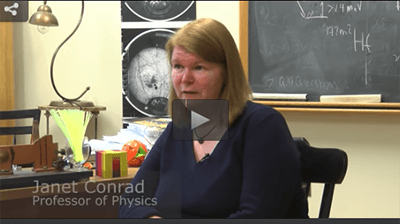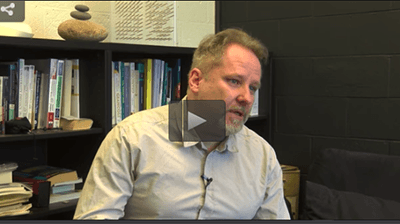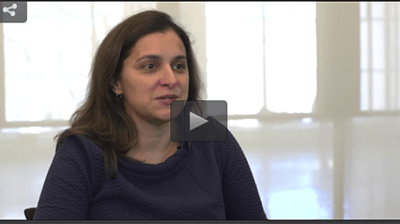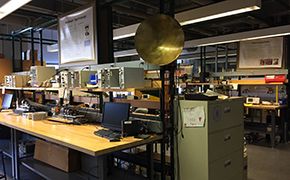Instructor Insights pages are part of the OCW Educator initiative, which seeks to enhance the value of OCW for educators.
MIT students . . . want to change the world. That's going to happen if, and only if, they can talk and write about (their research) effectively.
— Atissa Banuazizi
In the following videos, Professors Janet Conrad and Gunther Roland describe various aspects of how they teach “Junior Lab.” Dr. Sean Robinson shares his insights about facilitating the lab experiences associated with the courses, while Atissa Banuazizi discusses her role in developing students’ science communication proficiencies.
We used flipped classroom techniques to make the direct instruction the homework, and then had class time for students to interact with experts who could support their active learning.
— Sean Robinson
Below, Dr. Sean Robinson discusses the course re-design that shifted how instructors and students experience Junior Lab.
Teaching Assistant Insights
Junior Lab is a world class teaching lab. Even as a teaching assistant, you can learn skills important for your research.
— Aditya Pathak
Below, Aditya Pathak responds to questions about being a graduate teaching assistant in 8.13 Experimental Physics I.
OCW: Teaching assistantships vary from class to class. Please describe your role as a graduate teaching assistant in 8.13 Experimental Physics I.
Aditya Pathak: My role as a teaching assistant was to help students carry out experiments, which included helping them understand the experiments and debug common errors. I also graded their presentations and paper reports, along with the instructor, and graded other pre-lab homework problems.
OCW: What challenges did students face in the course?
Aditya Pathak: Students often went straight into the experiments without fully understanding the theory they were testing. Because Junior Lab emphasizes the quality of students’ analyses, they needed a lot of guidance.
Junior Lab also requires that students maintain harmonious and fair relationships with their lab partners. While most students got along well in my sections, it's not always a given.
› Read More/Read Less
Student Insights
In the following videos, five MIT students offer advice for future students taking Junior Lab and tips for educators facilitating similar experiences.
|
Saarik Kalia & Efetobore (Toby) Tasker Tal Scully |
Christina Wang
Henry Shackleton |
Below, Talia Weiss responds to questions about her experiences as a junior physics major enrolled in 8.13 Experimental Physics I.
I would advise future 8.13 students to use the first month of the class to proactively develop effective collaboration and organizational strategies with your partner.
— Talia Weiss
OCW: What did you learn about science communication by taking 8.13 Experimental Physics I?
Talia Weiss: Going into the course, I hoped it would expand my previous experience presenting physics research. 8.13 Experimental Physics I met and exceeded those expectations. It provided us with ample practice developing quality talks in a limited timeframe, crafting PowerPoint slides to most effectively and engagingly convey key points about an experiment, and ensuring that our content and presentation style was accessible and clear.
OCW: What factors contributed to your success in 8.13? Were there any teaching strategies your instructors used that particularly supported your learning?
Talia Weiss: The introductory period of the class, in which we learned relevant skills, conducted small experiments, presented an ungraded talk and wrote an ungraded paper, was particularly useful in preparing us to dive into more complex experiments and analyses. During this time period, the professor clearly established meaningful standards for quality of plot making and paper writing. Throughout the semester, instructors were consistently available to respond to questions. Dr. Robinson was always very gracious and willing to discuss lab procedures, experimental challenges (as they arose), and data analysis. In addition, I appreciated having the opportunity to improve presentation slides with the help of a writing instructor.
› Read More/Read Less
Physical Review Letters Editor Insights
Scientists are not born knowing how to communicate their results clearly.
— Robert Garisto
Students in Junior Lab write papers in the style of Physical Review Letters to hone their science communication skills. Below, Dr. Robert Garisto, an editor of this premier journal, responds to questions about helping students and young professionals develop professional competencies as writers in the field.
OCW: Please describe your role at Physical Review Letters (PRL).
Dr. Robert Garisto: The primary responsibility of a PRL editor is to decide, via a peer review process, which manuscripts submitted to PRL will be accepted for publication. I have a number of other roles, including deciding which papers we will highlight with a PRL Editors' Suggestion, managing several junior editors, and helping chart the course for the future of the journal.
OCW: What challenges do you see newly-minted physicists encountering in the realm of science communication?
Dr. Robert Garisto: As young researchers move further into a specific field, they focus on ever more arcane details, and tend to talk in acronym-laden jargon. The biggest communication challenge is bridging the gap between calculations and lab notes written in that jargon and a polished piece that the larger community can understand. This is a skill—scientists are not born knowing how to communicate their results clearly. And how well results are communicated is crucial to how much they will affect future research, and how broad their reach will be. So, it is essential that physicists learn to clearly and concisely explain their results. The best time to learn to do that is before writing habits become ingrained.
› Read More/Read Less
Curriculum Information
Prerequisites
- 8.04 Quantum Physics I is the prerequisite for taking 8.13 Experimental Physics I.
- 8.05 Quantum Physics II and 8.13 Experimental Physics I are the prerequisites for taking 8.14 Experimental Physics II.
Requirements Satisfied
- CI-M
 (8.13)
(8.13) - 8.13 and 8.14 can be applied toward a Bachelor of Science in Physics.
Offered
- 8.13 is offered every fall and spring semester and 8.14 is offered every spring semester.
Student Information

Enrollment
8.13’s enrollment is typically about 40 students, while 8.14’s enrollment is typically about 15 students.
Breakdown by Year
Mostly juniors
Breakdown by Major
Mostly physics majors
8.13 Experimental Physics I Assessment
The students' grades were based on the following activities:
 18% Lab attendance and performance & lab notebooks
18% Lab attendance and performance & lab notebooks 12% Homework exercises & three preparatory questions
12% Homework exercises & three preparatory questions 30% Oral examinations (3)
30% Oral examinations (3) 30% Four-page written summaries (3)
30% Four-page written summaries (3) 10% Final oral presentation (public)
10% Final oral presentation (public)8.14 Experimental Physics II Assessment
The students' grades were based on the following activities:
 19% Lab attendance and performance & lab notebooks
19% Lab attendance and performance & lab notebooks 6% Preparatory questions (3)
6% Preparatory questions (3) 27% Oral examinations (3)
27% Oral examinations (3) 16% Five-page written summaries (3)
16% Five-page written summaries (3) 32% Project proposal, poster, and peer review
32% Project proposal, poster, and peer reviewDuring an average week, students were expected to spend 18 hours on the course, roughly divided as follows:
In Class
- Met 2 times per week for 3 hours per session; 26 sessions total.
- The first few class sessions familiarized students with the lab, giving everyone a common foundation in safety, experimental techniques, data analysis, collaboration skills, oral and written communication, and computing tools.
- Next, students completed three short preliminary experiments in pairs.
- Following the introductory period, students planned, executed, and reported on three longer experiments, also in pairs.
- The term culminated in a week-long series of public oral presentations given by students in the style of a parallel session at an American Physical Society conference.
- There were optional open lab days offered toward the end of the semester.
Out of Class
- In-class work was complemented by a small number of graded homework assignments, some of which took place on the 8.13 MITx residential course site.
- Each experiment contained a set of preparatory questions which included the essentials of the experiment and safety information. Students were expected to work out the solutions to the preparatory problems in their lab notebooks and to submit answers on the 8.13 MITx residential course site before starting the experiment.
- For each main experiment, a one-hour oral examination and discussion was scheduled for each pair of lab partners. Students rehearsed for these exams outside of class. The oral exams were video-recorded so that students could review their presentation techniques.
- A written summary was prepared for each of the three standard experiments, plus one preliminary experiment. Students prepared these summaries individually outside of class. They were encouraged to work with writing consultants at the Writing and Communication Center.
- Students prepared their final oral presentations outside of class.
Semester Breakdown
| WEEK | M | T | W | Th | F |
|---|---|---|---|---|---|
| 1 |  |  |  |  |  |
| 2 |  |  |  |  |  |
| 3 |  |  |  |  |  |
| 4 |  |  |  |  |  |
| 5 |  |  |  |  |  |
| 6 |  |  |  |  |  |
| 7 |  |  |  |  |  |
| 8 |  |  |  |  |  |
| 9 |  |  |  |  |  |
| 10 |  |  |  |  |  |
| 11 |  |  |  |  |  |
| 12 |  |  |  |  |  |
| 13 |  |  |  |  |  |
| 14 |  |  |  |  |  |
| 15 |  |  |  |  |  |
| 16 |  |  |  |  |  |
 No classes throughout MIT
No classes throughout MIT Lab session
Lab session Open lab
Open lab Due date
Due date No class session scheduled
No class session scheduled Class meeting
Class meeting Public presentations
Public presentationsDuring an average week, students were expected to spend 18 hours on the course, roughly divided as follows:
In Class
- Met 2 times per week for 3 hours per session; 26 sessions total.
- The first class period was dedicated to selecting partners, choosing the first experiments, and brief introductory remarks by the section instructors.
- The remainder of the term was divided into four experimental sessions of 5 days each. Experiments for three of the four sessions were selected from the standard Junior Lab menu, while the fourth was an open-ended project of students’ own design.
- The open-ended project was evaluated based on a scientific poster prepared and presented in an open poster session at the send of the semester.
Out of Class
- Each experiment contained a set of preparatory questions which included the essentials of the experiment and safety information. Students were expected to work out the solutions to the preparatory problems in their lab notebooks and to submit answers on the 8.14 MITx residential course site before starting the experiment.
- For each main experiment, a one-hour oral examination and discussion was scheduled for each pair of lab partners. Students rehearsed for these exams outside of class. The oral exams were video-recorded so that students could review their presentation techniques.
- A written summary in the style of a Physical Review Letter was prepared for each of the three standard experiments. Students prepared these summaries individually outside of class. They were encouraged to work with writing consultants at the Writing and Communication Center.
- Students worked on their scientific posters and presentations outside of class.
Semester Breakdown
| WEEK | M | T | W | Th | F |
|---|---|---|---|---|---|
| 1 |  |  |  |  |  |
| 2 |  |  |  |  |  |
| 3 |  |  |  |  |  |
| 4 |  |  |  |  |  |
| 5 |  |  |  |  |  |
| 6 |  |  |  |  |  |
| 7 |  |  |  |  |  |
| 8 |  |  |  |  |  |
| 9 |  |  |  |  |  |
| 10 |  |  |  |  |  |
| 11 |  |  |  |  |  |
| 12 |  |  |  |  |  |
| 13 |  |  |  |  |  |
| 14 |  |  |  |  |  |
| 15 |  |  |  |  |  |
| 16 |  |  |  |  |  |
 No classes throughout MIT
No classes throughout MIT Lab session
Lab session Due date
Due date No class session scheduled
No class session scheduled Class meeting
Class meeting Public poster session
Public poster session





 Room 1 of 1
Room 1 of 1 